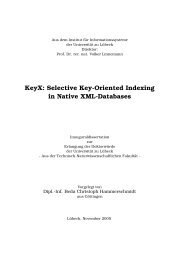Molecular characterisation of SGCE-associated myoclonus-dystonia ...
Molecular characterisation of SGCE-associated myoclonus-dystonia ...
Molecular characterisation of SGCE-associated myoclonus-dystonia ...
Create successful ePaper yourself
Turn your PDF publications into a flip-book with our unique Google optimized e-Paper software.
Discussion 77<br />
4.3 Parkinson’s disease: Mitochondrial function and morphology in patients<br />
with PINK1 mutations<br />
To date, studies investigating functional consequences <strong>of</strong> mutations in PINK1 were mostly<br />
performed in expression cell models, animal models or for very small groups <strong>of</strong> PD patients.<br />
Here, four siblings (from Family W, see 2.1.2.1 and Fig 4 for details) with the homozygous<br />
PINK1 p.Q456X nonsense mutation were examined and compared to a group <strong>of</strong> eight<br />
controls, three <strong>of</strong> whom were relatives <strong>of</strong> the affected cases. A PINK1 p.V170G missense<br />
sample was also included in the approach.<br />
4.3.1 Mutations in PINK1 alter respiratory chain enzyme activities<br />
Several research groups have recently demonstrated a link between the electron transport<br />
chain and PD (Hoepken et al., 2007; Parker et al., 1989; Piccoli et al., 2008). In Drosophila<br />
melanogaster a PINK1 knock-down was reported to cause mitochondrial dysfunction (Park et<br />
al., 2006). The NMD initiating mutation p.Q456X in PINK1 may also lead to loss <strong>of</strong> function<br />
in the homozygous members <strong>of</strong> Family W. However, the activities <strong>of</strong> the respiratory chain<br />
enzymes in fibroblasts <strong>of</strong> such nonsense mutants were not different from those in controls.<br />
This finding is analogous to results from Piccoli et al. (2008). The authors showed that<br />
fibroblasts with the homozygous p.W347X nonsense mutation have unaltered activities <strong>of</strong><br />
complex I, III and IV when measured spectrophotometrically. Why PINK1 haploinsuffiency<br />
does not result in a detectable impairment <strong>of</strong> the respiratory chain function in PD patients<br />
remains elusive.<br />
In contrast, for the p.V170G missense mutant fibroblasts complex I activity was low, although<br />
not significantly reduced. Decreased complex I activity is a common feature <strong>of</strong> several<br />
different forms <strong>of</strong> parkinsonism. NADH dehydrogenase deficiency has been discovered in the<br />
substantia nigra, platelets and fibroblasts <strong>of</strong> PD patients (Haas et al., 1995; Hoepken et al.,<br />
2007; Janetzky et al., 1994; Krige et al., 1992; Mann et al., 1994; Schapira et al., 1990b).<br />
Lacking significance <strong>of</strong> the complex I data presented here might be due to variations in the<br />
control values, a phenomenon which was observed earlier (Williams et al., 2001). However,<br />
reduced complex I activity was not present in all patients with PD in a study investigating<br />
lymphocyte mitochondria (Martin et al., 1996).<br />
For the combined measurement <strong>of</strong> complexes II and III, the missense mutant showed elevated<br />
activity. If there was indeed an inhibition <strong>of</strong> complex I in the p.V170G mutant, hyperactivity<br />
<strong>of</strong> complexes II and III could be interpreted as a compensatory mechanism to maintain

















